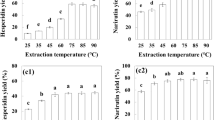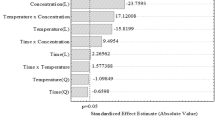Abstract
Ilex paraguariensis is a native tree from South America known for the presence of bioactive compounds, and its processed leaves are consumed as hot and cold infusions. After harvest (step 1), the leaves are subjected to flame blanching to inactive the enzymes (step 2), followed by drying and milling (step 3). The impacts of I. paraguariensis processing on leaf composition were investigated by extracting the major compounds (chlorogenic and isochlorogenic acids (3-CQA, 4-CQA, 5-CQA, 3,4-DQA, 3,5-DQA and 4,5-DQA), p-coumaric acid, caffeine and rutin) using different ratios of ethanol and water as extraction solvent (EW 25:75, 50:50, and 75:25 (w/w)). The solvent ratio of EW 50:50 was more effective in extracting the chlorogenic acids isomers, with retention of chlorogenic acids of 3463, 9485, and 9516 µg mL− 1 for steps 1, 2, and 3, respectively. Rutin and p-coumaric acid exhibited similar behavior with the increment of processing steps; however, p-coumaric acid was only detected in steps 2 and 3 for the solvent ratios EW 50:50 and 25:50. The caffeine extraction from I. paraguariensis varied from 936 to 1170 µg mL− 1 for all processing steps, with emphasis on its concentration extracted in step 1. The evolution of processing steps led to a higher retention of phenolic compounds from I. paraguariensis, which was not observed when using different solvent ratios, and the solvent ratio EW 50:50 was more effective for the extraction of chlorogenic acids. The successful extraction of chlorogenic acids from I. paraguariensis in this study proved to be a promising alternative for the use of yerba mate beyond the cuia cup.


Similar content being viewed by others
Data Availability
The datasets of the current study are available from the corresponding author on reasonable request.
References
Bracesco N, Sanchez AG, Contreras V et al (2011) Recent advances on Ilex paraguariensis research: minireview. J Ethnopharmacol 136:378–384. https://doi.org/10.1016/j.jep.2010.06.032
Pinto VZ, Pilatti-Riccio D, da Costa ES et al (2021) Phytochemical composition of extracts from yerba mate chimarrão. SN Appl Sci 3. https://doi.org/10.1007/s42452-021-04373-2
Heck CI, De Mejia EG (2007) Yerba mate tea (Ilex paraguariensis): a comprehensive review on chemistry, health implications, and technological considerations. J Food Sci 72. https://doi.org/10.1111/j.1750-3841.2007.00535.x
Burris KP, Harte FM, Michael Davidson P et al (2012) Composition and bioactive properties of yerba mate (llex paraguariensis A. St.-Hil.): a review. Chil J Agric Res 72:268–275. https://doi.org/10.4067/s0718-58392012000200016
de Vasconcellos AC, Frazzon J, Zapata Noreña CP (2022) Phenolic compounds present in yerba mate potentially increase human health: a critical review. Plant Foods Hum Nutr 2022 774 77:495–503. https://doi.org/10.1007/S11130-022-01008-8
da Silveira TFF, Meinhart AD, de Souza TCL et al (2017) Chlorogenic acids and flavonoid extraction during the preparation of yerba mate based beverages. Food Res Int 102:348–354. https://doi.org/10.1016/j.foodres.2017.09.098
da Silveira TFF, Meinhart AD, de Souza TCL et al (2017) Optimization of the preparation conditions of Yerba mate tea beverage to maximize chlorogenic acids extraction. Plant Foods Hum Nutr 72:219–223. https://doi.org/10.1007/s11130-017-0613-6
Pilatti-Riccio D, dos Santos DF, Meinhart AD et al (2019) Impact of the use of saccharides in the encapsulation of Ilex paraguariensis extract. Food Res Int 125. https://doi.org/10.1016/j.foodres.2019.108600
Nabechima GH, Provesi JG, Frescura JDO et al (2014) Thermal inactivation of peroxidase and polyphenoloxidase enzymes in mate leaves (Ilex paraguariensis) in a conveyor belt oven. CYTA - J Food 12:399–406. https://doi.org/10.1080/19476337.2014.900115
Cardozo Junior EL, Morand C (2016) Interest of mate (Ilex paraguariensis A. St.-Hil.) as a new natural functional food to preserve human cardiovascular health - a review. J Funct Foods 21:440–454. https://doi.org/10.1016/j.jff.2015.12.010
Esmelindro MC, Toniazzo G, Waczuk A et al (2002) Caracterização físico-química da erva mate: influência das etapas do processamento industrial. Ciência e Tecnol Aliment 22:199–204. https://doi.org/10.1590/s0101-20612002000200016
Nomura VH, Moreira BGM, Carniel AC et al (2022) Effects of an alternative bleaching method for yerba mate leaves on total phenolic content: evaluation and prediction with soft-computing approaches. J Sci Food Agric. https://doi.org/10.1002/jsfa.12055
Schmalko ME, Alzamora SM (2001) Color, chlorophyll, caffeine, and water content variation during yerba maté processing. Dry Technol 19:599–610. https://doi.org/10.1081/DRT-100103937
Butiuk AP, Martos MA, Adachi O, Hours RA (2016) Study of the chlorogenic acid content in yerba mate (Ilex paraguariensis St. Hil.): effect of plant fraction, processing step and harvesting season. J Appl Res Med Aromat Plants 3:27–33. https://doi.org/10.1016/j.jarmap.2015.12.003
Riachi LG, Simas DLR, Coelho GC et al (2018) Effect of light intensity and processing conditions on bioactive compounds in maté extracted from yerba mate (Ilex paraguariensis A. St.-Hil). Food Chem 266:317–322. https://doi.org/10.1016/j.foodchem.2018.06.028
Azmir J, Zaidul ISM, Rahman MM et al (2013) Techniques for extraction of bioactive compounds from plant materials: a review. J Food Eng 117:426–436. https://doi.org/10.1016/j.jfoodeng.2013.01.014
Xu DP, Li Y, Meng X et al (2017) Natural antioxidants in foods and medicinal plants: extraction, assessment and resources. Int J Mol Sci 18:20–31. https://doi.org/10.3390/ijms18010096
Bastos DHM, Saldanha LA, Catharino RR et al (2007) Phenolic antioxidants identified by ESI-MS from yerba maté (Ilex paraguariensis) and green tea (Camelia sinensis) extracts. Molecules 12:423–432. https://doi.org/10.3390/12030423
Tonet A, Zara RF, Tiuman TS (2019) Biological activity and quantification of bioative compounds in yerba mate extract and its application in fish hamburger. Brazilian J Food Technol 22:2018054. https://doi.org/10.1590/1981-6723.05418
Faccin C, Vieira LR, Freitas EM, De (2015) Application of yerba mate (Ilex paraguariensis a. St. -Hil.) In Food - a review. Cad pedagógico. Lajeado 12:200–209
Knapp MA, Santos DF, dos, Pilatti-Riccio D et al (2019) Yerba mate extract in active starch films: mechanical and antioxidant properties. J Food Process Preserv 43:1–12. https://doi.org/10.1111/jfpp.13897
Deladino L, Navarro AS, Martino MN (2013) Carrier systems for yerba mate extract (Ilex paraguariensis) to enrich instant soups. Release mechanisms under different pH conditions. LWT - Food Sci Technol 53:163–169. https://doi.org/10.1016/j.lwt.2013.01.030
Córdoba AL, Deladino L, Martino M (2014) Release of yerba mate antioxidants from corn starch-alginate capsules as affected by structure. Carbohydr Polym 99:150–157. https://doi.org/10.1016/j.carbpol.2013.08.026
Bruni GP, dos Santos Acunha T, de Oliveira JP et al (2020) Electrospun protein fibers loaded with yerba mate extract for bioactive release in food packaging. J Sci Food Agric 100:3341–3350. https://doi.org/10.1002/jsfa.10366
Schenk M, Ferrario M, Schmalko M et al (2021) Development of extracts obtained from yerba mate leaves with different industrial processing steps: antimicrobial capacity, antioxidant properties, and induced damage. J Food Process Preserv 45:e15482. https://doi.org/10.1111/JFPP.15482
Isolabella S, Cogoi L, López P et al (2010) Study of the bioactive compounds variation during yerba mate (Ilex paraguariensis) processing. Food Chem 122:695–699. https://doi.org/10.1016/j.foodchem.2010.03.039
Dawidowicz AL, Typek R (2017) Transformation of chlorogenic acids during the coffee beans roasting process. Eur Food Res Technol 243:379–390. https://doi.org/10.1007/s00217-016-2751-8
Gullón B, Eibes G, Moreira MT et al (2018) Yerba mate waste: a sustainable resource of antioxidant compounds. Ind Crops Prod 113:398–405. https://doi.org/10.1016/J.INDCROP.2018.01.064
Hartwig VG, Schmalko ME, Alzamora SM, Brumovsky LA (2013) Optimization of the extraction of antioxidants and caffeine from mate (Ilex paraguariensis) leaves by response surface methodology. Int J Food Stud 2:69–80. https://doi.org/10.7455/ijfs/2.1.2013.a6
Vanholme R, Storme V, Vanholme B et al (2012) A systems biology view of responses to lignin biosynthesis perturbations in Arabidopsis. Plant Cell 24:3506–3529. https://doi.org/10.1105/tpc.112.102574
Mehaya FM, Mohammad AA (2020) Thermostability of bioactive compounds during roasting process of coffee beans. Heliyon 6:e05508. https://doi.org/10.1016/j.heliyon.2020.e05508
Coentrão PDAM, Teixeira VL, Netto ADP (2011) Antioxidant activity of polyphenols from green and toasted mate tea. Nat Prod Commun 6:651–656. https://doi.org/10.1177/1934578x1100600516
Shalmashi A, Golmohammad F (2010) Solubility of caffeine in water, ethyl acetate, ethanol, carbon tetrachloride, methanol, chloroform, dichloromethane, and acetone between 298 and 323 K. Lat Am Appl Res 40:1–6
Provesi JG, Nabechima GH, Vieira MA, Amante ER (2010) Effect of thermal processing on oxide reductase inactivation and on colour fixing in erva-mate (Ilex paraguariensis St. Hill) leaves. Int J Food Sci Technol 45:971–977. https://doi.org/10.1111/j.1365-2621.2010.02221.x
Funding
Universidade Federal da Fronteira Sul (UFFS) grant # PES-2021-0196, and Fundação Araucaria for scholarship.
Author information
Authors and Affiliations
Contributions
David Fernando dos Santos and Vania Zanella Pinto contributed to the study conception and design; Material preparation and formal analysis were performed by David Fernando dos Santos, Edlaine Costa, André Martins and Alexia Flavia França Vieira; Data analysis were performed by David Fernando dos Santos, Vandressa Alves, Cátia Tavares dos Passos Francisco and Gustavo Henrique Fidelis dos Santos; Funding acquisition and project administration by Vânia Zanella Pinto and Gustavo Henrique Fidelis dos Santos; The first draft of the manuscript were written by David Fernando dos Santos, Vandressa Alves, Edlaine Costa, and Vânia Zanella Pinto. All authors commented on previous versions of the manuscript and approved the final manuscript.
Corresponding author
Ethics declarations
Ethical Approval and Participation Consent
Not applicable.
Consent for Publication
Not applicable.
Conflict of Interest
The authors have declared no conflict of interest.
Additional information
Publisher’s Note
Springer Nature remains neutral with regard to jurisdictional claims in published maps and institutional affiliations.
Electronic Supplementary Material
Below is the link to the electronic supplementary material.
Rights and permissions
Springer Nature or its licensor (e.g. a society or other partner) holds exclusive rights to this article under a publishing agreement with the author(s) or other rightsholder(s); author self-archiving of the accepted manuscript version of this article is solely governed by the terms of such publishing agreement and applicable law.
About this article
Cite this article
dos Santos, D.F., Alves, V., Costa, E. et al. Yerba Mate (Ilex paraguariensis) Processing and Extraction: Retention of Bioactive Compounds. Plant Foods Hum Nutr 78, 526–532 (2023). https://doi.org/10.1007/s11130-023-01082-6
Accepted:
Published:
Issue Date:
DOI: https://doi.org/10.1007/s11130-023-01082-6




